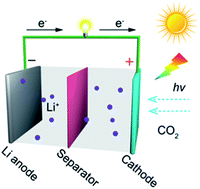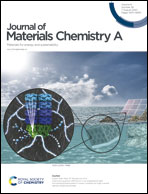In situ fabricated photo-electro-catalytic hybrid cathode for light-assisted lithium–CO2 batteries†
Abstract
Severe polarization triggered by the limited electrochemical activity of carbon dioxide as well as the insulating and insoluble discharge product Li2CO3 significantly impedes the practical application of Li–CO2 batteries. Herein, a light-assisted Li–CO2 system employing SiC/RGO as the photo-electro-catalytic hybrid cathode is presented to overcome the obstacle of polarization in conventional Li–CO2 cells. RGO is capable of transferring high-energy electrons generated on SiC after absorbing photons, inhibiting the recombination of photogenerated electrons. During the discharge process, the kinetics of CO2 reduction reaction is promoted by the photogenerated electrons. Thus, the discharge voltage of the battery is increased to 2.77 V, which is very close to the theoretical potential for 4Li + 3CO2 → 2Li2CO3 + C (2.80 V). Besides, the holes generated on the photoelectrode upon charging promote the decomposition of Li2CO3, effectively alleviating the overpotential of the Li–CO2 battery. Consequently, the system exhibits an excellent energy efficiency of 84.4%. These findings demonstrate the promising potential of the photo-assisted electrochemical process in addressing the overpotential issue of Li–CO2 batteries.



 Please wait while we load your content...
Please wait while we load your content...